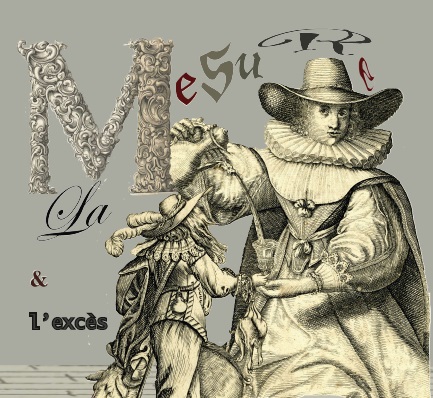COLLOQUE INTERNATIONAL ORGANISÉ PAR LA SEAA XVII-XVIII
« La mesure et l’excès / Measure and Excess »
Paris, 17-18 Janvier 2014
Université Paris 4
Maison de la Recherche, 28 rue Serpente 75006 Paris
Salle D35
Vendredi 17 janvier 2014
Accueil à partir de 9h
Séance 1 : Esthétique (1)
Président : Guillaume Coatalen
9h15 Gisèle Venet (Université Sorbonne Nouvelle – Paris 3), La mesure et l’excès: Horace et Ovide en conflit dans les esthétiques maniéristes et baroques?
9h45 Claire Bardelmann (Université de Lorraine), Un excès de mesures : complexité terminologique et constellation métaphorique de la « mesure » musicale anglaise au 17è siècle
10h15 Rémi Vuillemin (Université de Strasbourg), “Love with excess of heat”: reassessing Petrarchan excess in the late-Elizabethan and early-Jacobean periods
10h45 – 11h15 discussion et pause
Séance 2 : Esthétique (2)
Présidente : Marie-Madeleine Martinet
11h15 Christine Sukic (Université de Reims Champagne Ardenne), “a true signe of a readie wit” : la colère entre mesure et excès
11h45 Aurélie Griffin (Université d’Angers, doctorante Université Sorbonne Nouvelle – Paris 3), Melancholic Excess and Poetic Measure in Mary Wroth’s Pamphilia to Amphilanthus
12h15 Anne-Marie Miller-Blaise (Université Paris Sorbonne), Vehement Poesy : L’élégie et les codes de l’excès
12h45-14h30 Déjeuner libre
Vendredi 17 janvier 2014 (après-midi)
Président : Jean Viviès
14h30 Conférence de Abigail Williams (St Peter’s College, Oxford):
A Brief History of Eighteenth-Century Modesty
15h30 – 16h pause
16h Assemblée générale
18h30 cocktail (lieu à confirmer)
Samedi 18 janvier 2014
Séance 1 : La Jeune Amérique (politique)
Présidente : Marie-Jeanne Rossignol
9h30 Anne-Claire Faucquez-Merlin (docteur Université Paris 8 – Vincennes Saint-Denis), La fondation de la Nouvelle-Néerlande : entre la mesure des excès et excès de mesures
10h Élodie Peyrol-Kleiber (docteur Université Paris 8 – Vincennes Saint-Denis), L’engagement : un système servile poussant à l’excès
10h30 Lauren Working (Durham University), Violating the Body and the Law: Cannibal Discourses in Jacobean England and America
11h discussion et pause
Séance 2 : La Jeune Amérique (esthétique)
Présidente : Isabelle Bour
11h30 Juliette Dorotte (doctorante Université Paris Sorbonne), Le premier roman américain, entre autocensure et excès
12h00 Michael Burden (New College, University of Oxford), Opera and the discourse of Luxury in 18th-Century England and America
Déjeuner libre
Après-midi
Séance 1
Présidente : Madeleine Descargues
14h Christophe Hausermann (docteur Université Sorbonne Nouvelle – Paris 3), “Of our Measure we have been debar’d” : De la démesure dans les récits d’apprentissage de Thomas Deloney, Richard Head et Francis Kirkman
14h30 Alexandra Sippel (Université Toulouse – Le Mirail), “Under a perfect government […] the earth would soon be overstocked”: measure and excess of population in a few eighteenth-century utopias
15h Jeffrey Hopes (Université d’Orléans), Dating the world: the science of biblical chronology
15h30-16h discussion et pause
Séance 2
Président : Jeffrey Hopes
16h Nathalie Zimpfer (docteur Université Lyon 2), La mesure de l’excès : l’esthétique swiftienne de la satire
16h30 Damian Grant (University of Manchester), Smollett’s Travels between Measure and Excess
17h : clôture du colloque

